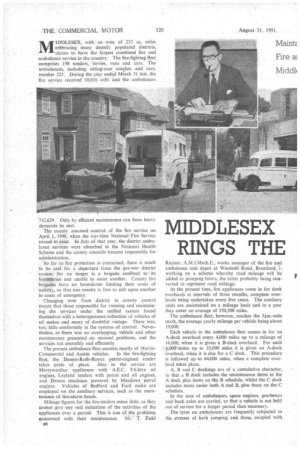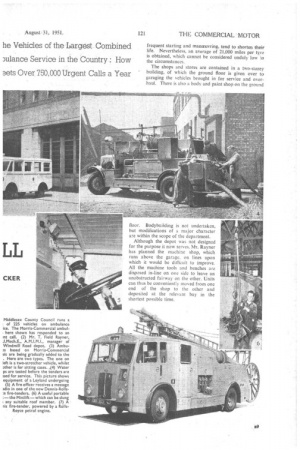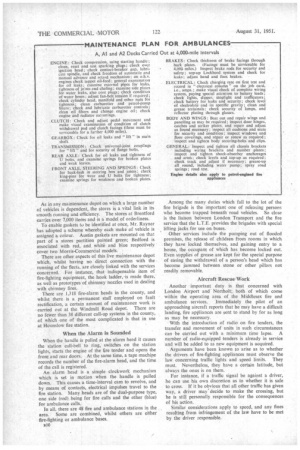MIDDLESEX RINGS THE
Page 42

Page 43

Page 44

If you've noticed an error in this article please click here to report it so we can fix it.
IDDLESEX, with an area of 232 sq, miles ertibracing many densely populated districts, claims to have the largest combined fire and ambulance service in the country. The fire-fighting fleet comprises 198 tenders, lorries, vans and cars. The ambulances, including sitting-case coaches and cars, number 225. During the year ended March 31 last, the fire service received 10,016 calls and the ambulances 742,629. Only by efficient maintenance can these heavy _demands be met.
The county assumed .control of the fire service on April 1, 1948, when the war-time National Fire Service ceased to exist. In July of that year, the district ambulance services were absorbed in the National Health Scheme and the county councils became responsible for administration.
So far as fire protection is concerned, there is much to be said for a departure from the pre-war district system, for no longer is a brigade confined to • its boundaries and unable to assist another. County fire brigades have no boundaries limiting their areas of activity, so that one county is free to call upon another in cases of emergency.
Changing over from district to county control Meant that those responsible for running and maintaining the services under the unified system found themselves with a heterogeneous collection of yehicles of all makes and many of doubtful vintage. There was, too, little •onformity in the systems of control. Nevertheless', as -there was no overlapping, vehicle and other maintenance presented no unusual problems, and the services ran smoothly and efficiently.
The present ambulance fleet consists mostly of Morris Commercial and Austin vehicles. In the fire-fighting fleet, the Dennis-Rolls-Royce petrol-engined tender takes pride of place. Also in the service are Merryweather appliances with A.E.C. 9.6-litre oil engines, Leyland tenders with petrol and oil engines, and Dennis machines powered by Meadows petrol engines. Vehicles of Bedford and Ford make are employed on the auxiliary services, such as the maintenance of tire-alarm heads.
Mileage figures for the fire-tenders mean little, as they cannot give any real indication of the activities of the appliances over a period. This is one of the problems concerned with their maintenance. Mi.' T.Field
Rayner, A.M.I.Mech.E., works manager of the fire and ambulance unit depot at Windmill Road, Brentford, working on a scheme whereby road mileage will be added to pumping hours, the latter probably being converted to represent road mileage.
At the present time, fire appliances come in for dock overhauls at intervals of three months, complete overhauls being undertaken every five years. The auxiliary units are maintained on a mileage basis and in a year they cover an average of 150,300 miles.
The ambulance fleet, however, reaches the 31m.-mile mark, the average yearly mileage per vehicle being about 19,000.
Each vehicle in the ambulance 'fleet comes in for an A-dock overhaul every 4,000 miles up to a mileage of 16,000, when it is given a B-dock overhaul. For each 4,000 miles up to 32,000 miles it is given an A-dock overhaul, when it is due for a C dock. This procedure is followed up to 64,000 miles, when a complete overhaul takes place.
A, B and C dockings are of a cumulative character, in that a B dock includes the maintenance items in the A dock plus items on the B schedule, whilst the C dock includes items under both A and B, plus those on the C schedule.
In the case of ambulances, spare engines, gearboxes and back axles are carried, so that a vehicle is not held out of service for a longer period than necessary.
The lyres on ambulances are frequently subjected to the .stresses of kerb jumping and these, coupled with
frequent starting and manceuvring, tend to shorten their life. Nevertheless, an average of 21,000 miles per tyre is obtained, which cannot he considered unduly low in the circumstances.
The shops and stores are contained in a two-storey building, of which the ground floor is given over to garaging the vehicles brought in for service and overhaul. There is also a body and paint shop on the eround floor. Bodybuilding is not undertaken, but modifications of a major character are within the scope of the department.
Although the depot was not designed for the purpose it now serves. Mr. Rayner has planned the machine shop, which runs above the garage, on lines upon which it would be difficult to improve. All the machine tools and benches are disposed in-line on one side to leave an unobstructed fairway on the other. Units can thus be conveniently moved from one end of the shop to the other and deposited at the relevant bay in the shortest possible time.
As in any maintenance depot on which a large number of vehicles is dependent, the stores is a vital link in its smooth running and efficiency. The stores at Brentford carries over 7,000 items and is a model of orderliness.
To enable gaskets to be identified at once, Mr. Rayner has adopted a scheme whereby each make of vehicle is assigned a colour. Austin gaskets are mounted on that part of a stores partition painted green; Bedford is associated with red, and white and blue respectively cover two Morris-Commercial models.
There are other aspects of this live maintenance depot which, whilst having no direct connection with the running of the fleets, are closely linked with the services concerned. For instance, that indispensable item of fire-fighting equipment, the hook ladder, 'is made there, as well as prototypes of chimney nozzles used in dealing with chimney fires.
There are 1,318 fire-alarm heads in the county, and whilst there is a permanent staff employed on fault rectification, a certain amount of maintenance work is • carried out at the Windmill Road depot. There are no fewer than 38 different call-up systems in the county, of which one of the most complicated is that in use at Hounslow fire station.
When the Alarm is Sounded
When the handle is pulled at the alarm head it causes the station call-bell to ring, switches on the station lights, starts the engine of the fire tender and opens the front and rear doors. At the same time, a tape machine records the number of the fire-alarm head, and the time of the call is registered.
An alarm head is a simple clockwork mechanism which is set in motion when the handle is pulled down. This causes a time-interval cam to revolve, and by means of contacts, electrical impulses travel to the fire station. Many heads are of the dual-purpose type, one side (red) being for fire calls and the other (blue) for ambulance calls.
In all, there are 48 fire and ambulance stations in the area. Some are combined, whilst others are either fire-fighting or ambulance bases.
Among the many duties which fall to the lot of the fire brigade is the important one of releasing persons who become trapped beneath road vehicles. So close is the liaison between London Transport and the fire service that the L.T.E. provides the brigades with special lifting jacks for use on buses.
Other services include the pumping out of flooded premises, the release of children from rooms in which • they have locked themselves, and gaining entry to a house, the occupant of which has become locked out. Even supplies of grease are kept for the special purpose of easing the withdrawal of a person's head which has become jammed between stone or other pillars not readily removable.
Aircraft Rescue Work
Another important duty is that concerned with London Airport and Northolt; both of which come within the operating area of the Middlesex fire and ambulance services. Immediately the pilot of an approaching aircraft reports that he may have a difficult landing, fire appliances are sent to stand by for as long as may be necessary.
With the introduction of radio on fire tenders, the transfer and movement of units in such circumstances can be carried out with a minimum time lapse. A number of radio-equipped tenders is already in service and will be added to as new equipment is acquired.
Arguments have been known to arise as to whether the drivers of fire-fighting appliances must observe the law concerning traffic lights and speed limits. They must. Nevertheless, they have a certain latitude, but always the onus is on them.
For instance, if a traffic signal be against a driver, he can use his own discretion as to whether it is safe to cross. If it be obvious that all other traffic has given way, a driver may 'decide to make the crossing, but he is still personally responsible for the consequences of his action.
Similar considerations apply to speed, and any fines resulting from infringement of the law have to be met by the driver responsible.




















































































